After postponing the trip a few times, because of circumstances beyond our control, we finally managed to leave for Thangpalkot early morning of Sunday, August 18 to start the Social Business for Education project–the Fishery. The group consisted of myself, my friend and COMMITTED Executive Director Jayjeev, another COMMITTED staff Shobha, our fishery expert Madhabji and two cage builders from Kulekhani fishery.
We arrived in the village mid-afternoon after a 4×4 landcruiser ride to Tipeni, followed by an hour or so of walking, rounded off by another hour or so of another 4×4 landcruiser ride.
We couldn’t take the first landcruiser all the way to the village as the bridges hadn’t been completed. Besides, parts of the road in between was covered with rocks and debris from a recent landslide. The travel time this time was much less than the last time I travelled to the village, since we traveled in style! (The style was to ensure Madhabji’s comfort as he has bad knees and can’t walk long distances and especially uphill.)
Early Monday morning, in preparation for the hatchlings due to arrive later that morning, the team of fishery experts started working on the cages, instructing and teaching our local supervisor/caretaker on the process involved. The team built two different size cages. All we needed were the hatchlings.
Murphy’s Law dictates most events in Nepal!
The government-owned, and run, fishery in Kathmandu we had arranged to buy the hatchlings from, the collection team found out Monday morning that they couldn’t deliver. When the two-man collection team showed up, they discovered to their (and our) horror that about 50% of the hatchlings had died because of the carelessness of those responsible for transferring them from the nursery to the oxygen-filled polythene bags! What’s more, they didn’t have any more hatchlings! Madhabji came to the rescue. Using his connections he was able to find a private fishery in Chitwan!
The fishery promised to deliver the number and variety of hatchlings we were after–three numbering 6000 in total. Mortality, we were told, would be high, to the tune of about 20%, because of the distance and difficulty of transportation involved. We had to take the chance. The very next day, Tuesday morning, the collection team would have to leave for the town of Chitwan, about 180 km south-west of Kathmandu, a bus ride lasting over 5 hours. Load up the hatchling in a vehicle and travel back to the village that same evening!
While the collection team travelled to Chitwan, Tuesday morning the fishery in Chitwan prepared the hatchlings for the overnight transportation on a 4×4 vehicle all the way to Tipeni. They would then be ported on the backs of eight villagers to Thangpalkot. The cooler temperature at night would minimize mortality during transportation. The collection team departed Chitwan around 9 pm Tuesday. Villagers hired for the portage of the fish left the village early morning Wednesday, around 2 am, to meet them in Tipeni. Each of the eight villagers would end up carrying about 30kg load for a gruelling 5-plus hour walk, mostly uphill! Incredibly enough, the hatchlings arrived with barely a 1% mortality!
After brief conditioning on the pond water, to aclimatize them to the temperature of the pond, the hatchlings were released into the two cages to the greatest relief of all the team members!
|
|
|
|
|
|

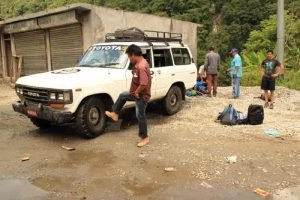
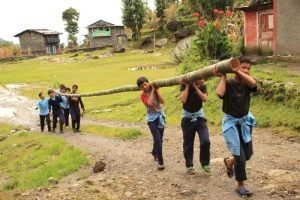
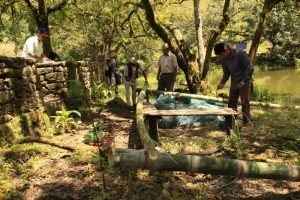
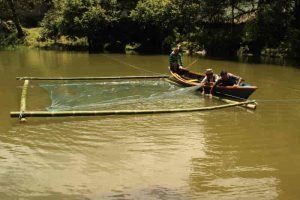
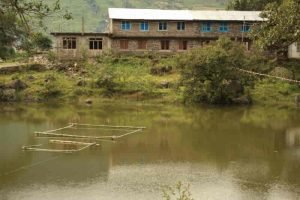
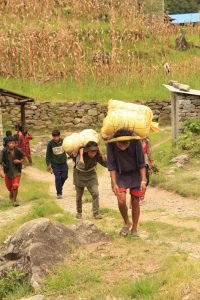
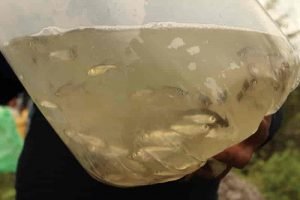
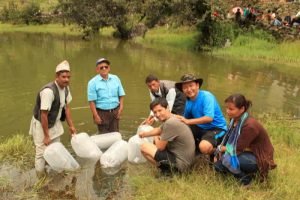
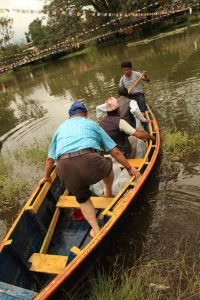
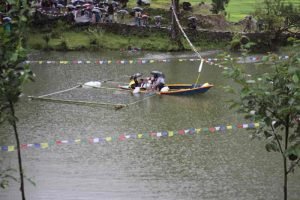

Well done Dorje, getting the fish to pond , I look forward to following this project. What species of fish is that? Tilapia ?
Hey Timothy, no, not Tilapia. They belong to the carp family. And the three species being common, big head and silver.